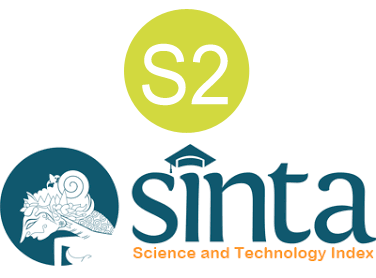Kajian Teologi Pemujaan Gaņeśa di Pura Ponjok Batu Kecamatan Tejakula Kabupaten Buleleng
DOI:
https://doi.org/10.37329/jpah.v7i1.1989Keywords:
Theology, Worship of Lord Ganesa, Ponjok Batu TempleAbstract
The existence of the dieties of Gaņeśa and the Nandini ox in one place at Ponjok Batu Temple has caused many perceptions, considering that in Hindu literature it is stated that the ox is the vehicle of Lord Shiva and the rat is the vehicle of Lord Gaņeśa. The purpose of this research is to find out the function and meaning of the theology of worshiping God Gaņeśa at Ponjok Batu Temple. This research includes descriptive qualitative research, the primary data source of this research is the result of interviews with informants. Data collection methods in this study are interviews, library research, and observation. The worship of Ganeśa and the Nandini ox at Ponjok Batu Temple has a theological function, namely the function of Ganeśa as a barrier to obstacles or awighneswara, the function of Ganeśa as the god of war which is proven every ceremony (piodalan) offering arrow dance, the function of worshiping Ganesha and the Nandini ox is a fusion of two sects Ganeśa as a symbol of the Ganapati sect while the Nandini ox as a symbol of the Saiwa sect, and the function of giving knowledge is known in Hindu literature that Ganeśa is the god of wisdom and knowledge. The worship of Lord Ganeśa at Ponjok Batu Temple has a meaning that is felt by the people of Tejakula, namely, the tattwa meaning that worship of Lord Gaņeśa leads to liberation, the meaning of Bhakti Yoga, namely the belief that Hindus worship Ganeśa sincerely reflects one way of liberation, namely bhakti-yoga, and the meaning of family, because at Ponjok Batu Temple not only worships Gaņeśa, but also iwa and the ox Nandini who are one Shiva family.
References
Atmadja, B. I. (1999). Gaņeśa Sebagai Avighnesvara, Vinayaka, &Penglukat. Surabaya: Paramita.
Atmadja, B. I. (2014). Saraswati & Ganesha Sebagai Simbol Paradigma Interpretative & Positivisme. Singaraja: Pustaka Larasan.
Awaru, O. T. (2020). Sosiologi Keluarga. Jawa Barat: Media Sains Indonesia.
Bagus, Gede Anak Agung. Arca Ganesa Bertangan Delapan Belas di Pura Pingit Melamba Bunutin Bangli. (2015). Forum Arkeologi. 25-34
Budiati, A. (2009). Sosiologi Kontekstual X SMA&MA. Jakarta: Pusat Perbukuan Departmen Pendidikan Nasional.
Chinmayananda, S. (2002). Kejayaan Gaņeśa. Surabaya: Paramita.
Dewantara, Anak Agung Gede Raka. Kajian Ikonografi dan Fungsi Arca Hindu-Budha di Pura Agung Batan Bingin Pejeng Kawan. (2020). Humanis: Jurnal of Art and Humanities. 266-273
Endraswara, S. (2006). Metodologi Penelitian Kebudayaan. Yogyakarta: Gajah Mada University Press.
Goris, R. (1986). Sekte-Sekte di Bali. Jakarta: Bharata Karya Aksara.
Gulo.W. (2002). Metodologi Penelitian. Jakarta: Grasindo.
Kusuma Dewi, Ni Wayan Sri Prabawati. Pola Asuh Anak Menurut Chanakya Niti Shastra. (2019). Adi Widya: Jurnal Pendidikan Dasar.82-91
Maliarsa, J. M. (2020). Kahyangan Jagat Pura Sidhi Ponjok Batu Buleleng Bali. Denpasar: Pustaka Larasan.
Mirsha, I Gusti Ngurah Rai. (1989). Ganapati Tattwa Kajian Teks & Terjemahannya. Denpasar: Upada Sastra.
Pudja, I. G. (1999). Bhagavad Gita (Pancama Veda). Surabaya: Paramita.
Redig, I. W. (2017). Pengarcaan Ganesha Masa Sekarang di Denpasar. Sphatika: Jurnal of Archeology and culture, 17-28.
Sanjaya, O. G. (2013). Siwa Purana. Surabaya: Paramita.
Singh, T. (2013). Vedanta and Embryology. Kolkata: Bhaktivedanta Institute.
Sura, D. (2002). Siwa Tattwa. Denpasar: Upada Sastra.
Titib, I. M. (1996). Perkawinan & Kehidupan Keluarga Menurut Kitab Suci Veda. Surabaya: Paramita.
Titib, I. M. (2003). Teologi & Simbol-Simbol dalam Agama Hindu. Surabaya: Paramita.
Wasa, S. A. (2014). Ganachakra. Lombok.
Wiana, I. K. (2013). Dasar-Dasar Agama Hindu. Denpasar: Manik Geni.
Wirawan, I. M. (2010). Kisah Kemuliaan Dewa Ganesha Sang Penghalau Rintangan Putra Dewa Siwa & Dewi Parwati. Surabaya: Paramita.
Wirawan, I. M. (2011). Cahaya Kebijaksanaan Gaņeśa. Surabaya: Paramita.
Downloads
Published
How to Cite
Issue
Section
License
Copyright (c) 2023 Ida Made Windya, Putu Sri Marselinawati

This work is licensed under a Creative Commons Attribution-ShareAlike 4.0 International License.
An author who publishes in the Jurnal Penelitian Agama Hindu agrees to the following terms:
- Author retains the copyright and grants the journal the right of first publication of the work simultaneously licensed under the Creative Commons Attribution-ShareAlike 4.0 License that allows others to share the work with an acknowledgement of the work's authorship and initial publication in this journal
- Author is able to enter into separate, additional contractual arrangements for the non-exclusive distribution of the journal's published version of the work (e.g., post it to an institutional repository or publish it in a book) with the acknowledgement of its initial publication in this journal.
- Author is permitted and encouraged to post his/her work online (e.g., in institutional repositories or on their website) prior to and during the submission process, as it can lead to productive exchanges, as well as earlier and greater citation of the published work (See The Effect of Open Access).
Read more about the Creative Commons Attribution-ShareAlike 4.0 Licence here: https://creativecommons.org/licenses/by-sa/4.0/.








